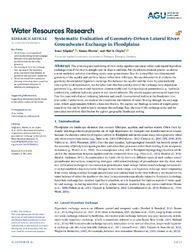Systematic Evaluation of Geometry‐Driven Lateral River‐Groundwater Exchange in Floodplains
DOI: https://doi.org/10.1029/2021WR030239
Persistent URL: http://resolver.sub.uni-goettingen.de/purl?gldocs-11858/9860
Persistent URL: http://resolver.sub.uni-goettingen.de/purl?gldocs-11858/9860
Allgeier, Jonas; Martin, Simon; Cirpka, Olaf A., 2021: Systematic Evaluation of Geometry‐Driven Lateral River‐Groundwater Exchange in Floodplains. In: Water Resources Research, Band 57, 8, DOI: 10.1029/2021WR030239.
 |
Dokument öffnen: |
The widening and narrowing of river‐valley aquifers can cause valley‐scale lateral hyporheic exchange even if the river is straight and its slope is uniform. For the aforementioned system, we derive a semi‐analytical solution describing steady‐state groundwater flow for a simplified two‐dimensional geometry of the aquifer and uniform lateral influx from hillslopes. We use this solution to evaluate the geometry‐driven lateral hyporheic exchange flux between the aquifer and the river. By systematically varying the model parameters, we decipher how this flux and the area of the exchange zone depend on geometric (e.g., minimum and maximum domain width) and hydrogeological parameters (e.g., hydraulic conductivity, ambient hydraulic gradient and lateral influxes). The results suggest pronounced hyporheic flow for cases with distinct widening behavior and small cross‐sectional widths at the floodplain inlet and outlet. Furthermore, we analyze the travel‐time distribution of water flowing through the exchange zone, which approximately follows a beta distribution. We express our findings in terms of simple proxy‐equations that can be used to easily estimate the exchange flux, the area of the exchange zone, and the associated travel‐time distribution for a given geographic/landscape setting. Key Points:
We develop a semi‐analytical solution describing lateral exchange between rivers and floodplain aquifers driven by the valley geometry.
We investigate how the exchange flux, the area of the hyporheic zone, and travel times depend on geometric and hydraulic properties.
We derive simplified expressions allowing estimating these quantities as a preliminary step prior to detailed site investigations.
Statistik:
ZugriffsstatistikSammlung:
- Geographie, Hydrologie [454]
Schlagworte:
valley‐scale hyporheic exchangesemi‐analytical model
proxy model
exchange flux
exchange area
travel‐time distribution
This is an open access article under the terms of the Creative Commons Attribution‐NonCommercial License, which permits use, distribution and reproduction in any medium, provided the original work is properly cited and is not used for commercial purposes.

